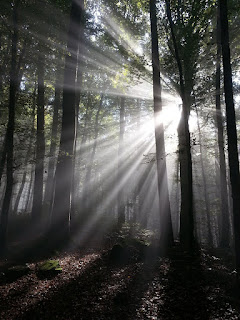Scattering of light means to throw light in various random directions. Light is scattered when it falls on various types of suspended particles in its path. Depending on the size of particles, she the scattering can be of white sunlight as such or of the coloured lights which make up the white sunlight. As we well study after a while, the blue colour of the sky and the red colour of the sun at sunrise and at sunset can be explained on the basis of scattering of light caused by the earth's atmosphere (or air). We will first describe the Tyndall effect.
Tyndall effect
The scattering of light by particles in its path is called Tyndall effect. When a beam of sunlight enters as dusty room through a window, then its path becames visible to us. This is because the tiny dust particles present in the air of room scatter the beam of light all dust particles present in the air of room scatter the beam of light all around the room. And when this scattered light enters our eyes, we can see the beam of light. Thus an example of Tyndall effect is the way a beam of sunlight becomes visible as it passes through dust particles in the air of a room.
Tyndall effect can also be observed when sunlight passed through the canopy of a dense forest. Here, tiny water droplets in the mist scatter sunlight.
We have just studies the spectrum of sun's white light which consists of seven coloured lights. If we look at the spectrum of white sunlight, we will observe that the reds and blues are very predominent in it. Red coloured light has a longer wavelength but the blue coloured light has a shorter wavelength.
In fact, the wavelength of blue light is almost half that of the the red light, In1859, in an attempt to explain the blue colour of the sky, Tyndall discovered that when white light consisting of seven colours is passed through a clear liquid having small suspended particles in it, then the blue color of white light having shorter wavelength is scattered much more than the red colour having longer wavelength.
Blue light has shorter wavelength, so it is scattered more easily. On the other hand, red light has longer wavelength, so it is not scattered much. In other words, the blue coloured light present in white sunlight is scattered much easily more easily than the red light. In fact, the light present in sunlight is scattered 10 times more than the red light.
The Colour of Scattered Light Depends on the Size of Scattering Particles
The earth's atmosphere is a heterogeneous mixture of minute particles. These parties include suspended particles of dust , tiny water droplets and molecules of air (air molecules of air means the molecules of gases like nitrogen and oxygen which make up the air).
When light coming from the sun strikes the particles present in the atmosphere (or air), then what happens to the light depends on its wavelength and size of the particles it hits.












